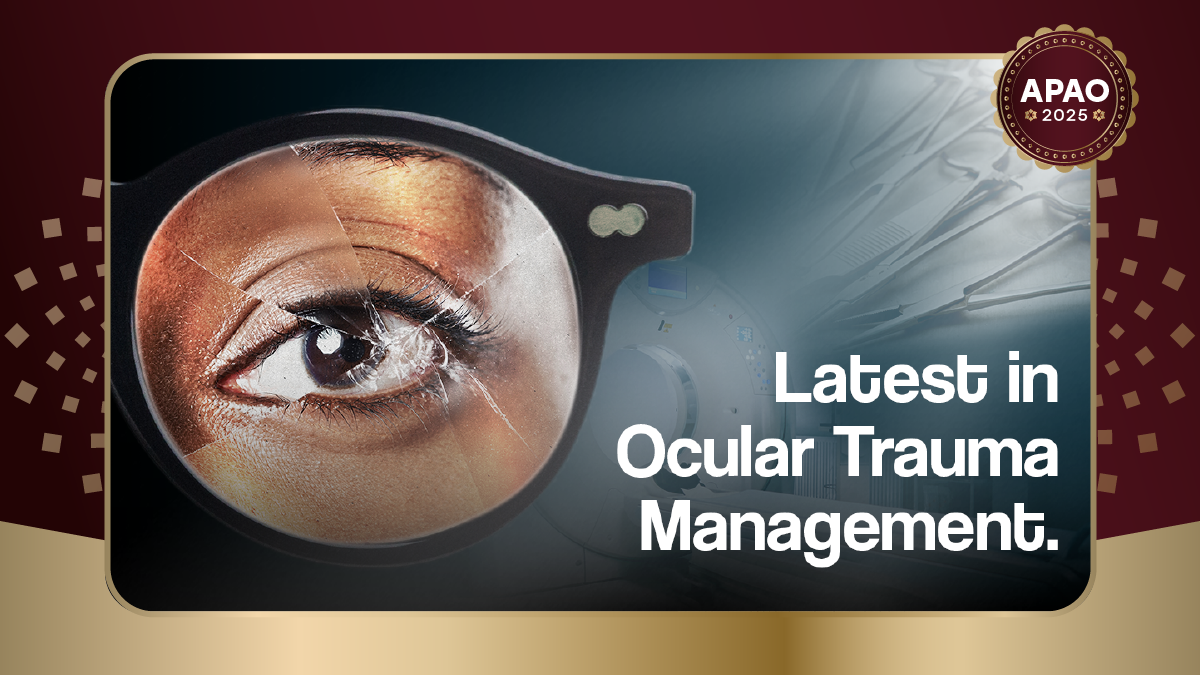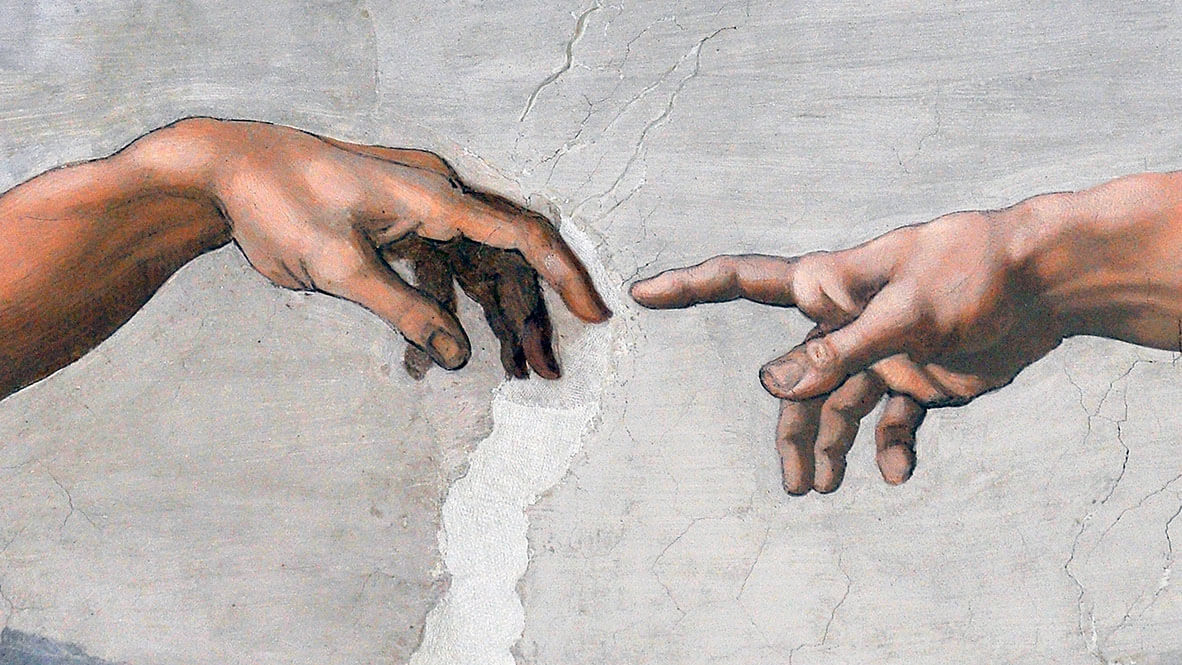Shuttlecocks, keratoprostheses and optic nerve shocks—ophthalmic trauma got REAL at APAO 2025.
On Day 3 of the 40th Congress of the Asia-Pacific Academy of Ophthalmology (APAO 2025)—held in conjunction with the 83rd Annual Conference of the All India Ophthalmological Society (AIOC 2025) in New Delhi—things got intense at the Asia Pacific Ophthalmic Trauma Society (APOTS) Symposium, titled In the Blink of an Eye: Understanding Ophthalmic Trauma. And true to its name, it delivered a fast-paced, no-holds-barred session.
Chaired by Indian experts Prof. Dr. Sundaram Natarajan and Dr. Purendra Bhasin, the discussion covered a wide range of topics—from trauma classifications to the surprising world of shuttlecock injuries.
Anterior segment reconstruction after trauma
Dr. Fasika Woreta (United States) kicked things off with a practical dive into anterior segment reconstruction.
“When we think about anterior segment reconstruction after trauma, we can start thinking about corneal injuries, iris injuries, cyclodialysis clefts and traumatic cataract or zonular injuries, which can lead to the subluxation of the native lens or intraocular lens—and, rarely, traumatic apraxia,” she began, setting the stage for a layered and clinically rich session.
One highlight was her emphasis on using temporary keratoprostheses to restore retinal access when the cornea is compromised. “When we have corneal trauma in the setting and posterior segment trauma, sometimes, because of the need for early intervention for the retina, we have to consider temporary keratoprosthesis,” she explained.
While effective, Dr. Woreta cautioned that “these cases, unfortunately, usually have a poor prognosis… graft failure occurred in 60% of cases, and trauma was a risk factor for that.”
Turning to traumatic cataracts, she reminded clinicians: “Whenever you have a patient present for a cataract evaluation, you have to ask about a history of trauma—especially if it’s asymmetric or it’s a young patient,” noting that “the most common cause of ectopia lentis is trauma.”
READ MORE: Anterior Segment Continues to Push the Boundaries in Vision Care
Imaging in ophthalmic trauma
Shifting to imaging, Dr. Rajiv Raman (India) offered a sharp overview of choosing the right tools. “The choice of imaging essentially depends on whether it’s a closed globe or an open globe injury.”
When dealing with closed-globe injuries, he said, “Both ultrasound B-scan and CT scan play important roles, depending on the presence or absence of media opacities. If the media is clear, you can use OCT. If there’s an opacity, ultrasound becomes especially valuable.”
He highlighted the indications for ultrasound: “It’s useful whenever there’s a media opacity and you suspect globe disruption, coat rupture, intraocular foreign bodies, endophthalmitis, orbital hemorrhages, hematomas, abscesses, optic nerve injury or infection.”
Further, “UBM also has an important role in trauma. It helps detect angle recession, iridodialysis, cyclodialysis and many anterior segment foreign bodies. CT scans are essential for both intraocular and extraocular trauma. They’re particularly helpful for identifying fractures—like medial wall, superior rim or orbital roof fractures.”
READ MORE: Pentacam Cornea OCT Offers Synergy for the Future of Corneal Assessment
Shuttlecock trauma: small object, big ocular impact
Then came badminton. Dr. Donny W. Suh (United States) delivered a striking look at shuttlecock injuries, revealing how a five-gram object traveling at up to 300 miles can wreak havoc.
He shared a compelling case of a 21-year-old patient with redness, photophobia, hyphema and possible retinal detachment after being struck mid-match.
But the real game-changer? His lab’s development of a finite element model simulating how force travels through the eye during impact. The model revealed stunning insights: pressure concentrates at the ciliary body and limbus, causing limbal stem cell damage, zonular stretching and angle recession.
Force bounces through the eye, even displacing the optic nerve—especially in older patients with a stiffened lamina cribrosa—raising the risk of optic neuropathy. Unlike shaken baby syndrome, shuttlecock trauma predominantly affects the preretinal space, explaining unique hemorrhage patterns.
Dr. Suh’s ultimate message was clear: wear protective glasses, which will reduce the force by 90%.
Neuro-ophthalmic aspects of ocular trauma
Dr. An-guor Wang (Taiwan) brought a cutting-edge look into the neuro-ophthalmic side of ocular trauma, zeroing in on something that doesn’t always get the spotlight: extraocular muscle injury.
Dr. Wang referenced a key 2015 study by Dr. Jingchang Chen, which reviewed cases of isolated rectus muscle rupture at the Zhongshan Ophthalmic Center (China) between 2003 and 2014. The study analyzed 36 cases in total.1 Among those, “The most commonly involved muscle was medial rectus muscle, followed by the inferior rectus muscle.”
In one complex case, Dr. Wang described managing a patient with thyroid eye disease and multiple rectus ruptures using a novel interdisciplinary technique. His team collaborated with ENT surgeons to access the orbit via a transethmoidal endoscopic route. “We reported the first case of endoscopic repair procedure for the inferior rectus muscle through transethmoidal endoscopic exploration with a navigation system.”
When the ruptured muscle’s proximal end is found, “we can do the end-to-end anastomosis.” If not, “we need to do the transposition of the rectus muscle.” In this case, the strategy worked.
Rehabilitation strategies for ocular trauma survivors
Dr. Danial Bohan (Singapore), an expert in low vision and rehabilitative optometry, delivered a moving and practical talk on the often-overlooked area of ocular trauma rehabilitation.
He focused on the real-life impact of trauma, using the case of a young fencing athlete who lost vision in one eye after an accident. His presentation emphasized the importance of structured post-trauma care and introduced practical strategies for helping patients regain function and independence.
Dr. Bohan presented a patient-centered model: “We aim to preserve the eye, restore function and normalize life—or PRN for short.” Through this approach, his team intervened early, offering bedside care just one day post-surgery.
He also emphasized a trauma-informed care model, noting, “This framework aims to create a supportive system and process and is guided by five core principles: safety, trustworthiness, choice, collaboration and empowerment.”
READ MORE: From Trauma to Recovery
A roadmap to elevate and unify ophthalmic trauma care
Prof. Dr. Rupesh Agrawal (Singapore) brought both vision and urgency to the stage as he explored the evolving journey of ophthalmic trauma through its past, present and future.
Drawing on decades of evidence and personal experience, Prof. Agrawal called for more robust trauma fellowships, structured units and a unified global community. “If we are not going to train, we are going to lose that eye,” he warned, emphasizing the importance of saving vision through timely collaboration.
Looking ahead, he outlined a bold but practical vision: AI-powered dashboards, global trauma registries and trauma-informed education systems that bring cohesion to a fragmented space.
With a call for collaboration, cross-society alignment and embracing polytrauma integration, Prof. Agrawal laid out an inspiring challenge: not just to recognize ophthalmic trauma—but to elevate, unify and innovate its future.
A global call to action
In the end, the APOTS Symposium had sparked something vital. What began as a deep dive into trauma classifications and rare injury mechanisms ended as a collective call to action. Each session carved out a new dimension of how we understand, diagnose, treat and rehabilitate ophthalmic trauma—from imaging nuance and surgical precision to patient-centered recovery.
Experts didn’t just share knowledge; they issued invitations. Dr. Bohan reminded us that “life after trauma is complex and multidimensional,” yet through early intervention and compassionate care, recovery can be transformative. And Prof. Agrawal left us with a rallying vision: a world where trauma care is no longer sidelined but embedded into ophthalmology’s global framework.
From science to systems, from damage control to healing, Day 3 was a blueprint in motion. If ophthalmic trauma once lived in the margins, today it began writing itself into the future.
Editor’s Note: Reporting for this story took place during the 40th Congress of the Asia-Pacific Academy of Ophthalmology (APAO 2025), being held in conjunction with the 83rd Annual Conference of the All India Ophthalmological Society (AIOC 2025) from 3-6 April in New Delhi, India.
Reference
- Chen J, Kang Y, Deng D, et al. Isolated total rupture of extraocular muscles. Medicine (Baltimore). 2015;94(39):e1351.



